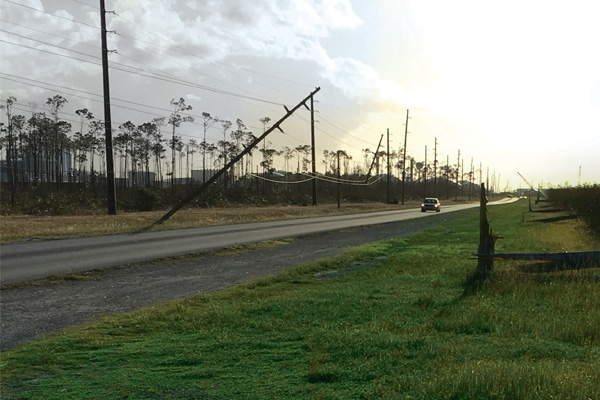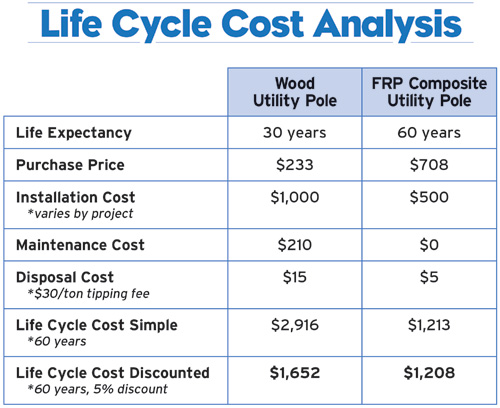Nearly 175 years after America’s first wooden utility poles were installed to carry telegraph wires from Washington, D.C. to Baltimore, they have become a classic element of the American landscape. Today, an estimated 185 million utility poles carry telephone and electrical lines along the nation’s highways and byways, powering homes and businesses both urban and rural.
However, an average of 2.5 million of the roughly 130 million poles made from wood need to be replaced each year due to loss from age, rot, decay and, in the most high-impact instances, weather events.
And when it comes to storm zones, which endure an estimated $18-33 billion in damage annually, the economic impact of downed poles is far greater than just the cost of infrastructure replacement. Wide-scale grid failures impede the movement of manufactured goods, leading to residual losses of critical food and pharmaceuticals.
These outages immediately halt economic activity through the loss of mass transit, traffic lights, electronic tolling stations, and retail cash registers. They also raise recovery costs related to mobilization, backup power provision, and temporary housing. To make matters worse, the frequency and costs of storms are on the rise.

©TECO/EMERA 2016
According to a 2013 White House Report, Economic Benefits of Increasing Electric Grid Resilience to Weather Outages, storms in recent years have resulted in more widespread damage and a higher cost of recovery (averaging $40-75 billion per year) than those of the 1900s. Looking at power outages specifically, a recent report from the Lawrence Berkeley National Laboratory, Assessing Changes in Reliability of U.S. Electric Power System, found that customers have experienced a 260 percent increase in outage duration from major weather events over the last 15 years.

Source: “Cycle Assessment of Composite vs. Ceramic Transmission Insulator (Part 1) And of Composite
vs. Wood Utility Pole (Part 2)”, Daniel Mays, John Xu, Ryan Powanda, Sara Timtim, Stanford, 2009
Recent natural disasters have vindicated these trends. Hurricane Harvey, for example, destroyed 5,000 wooden utility poles and left 250,000+ people powerless for numerous days in August 2017, inflicting a record-setting $125 billion in damage. One month later, Hurricane Maria brought down 80 percent of Puerto Rico’s wooden poles and caused an island-wide power and communication blackout that lasted for weeks.
Given these facts and figures, it’s no surprise that some regions that regularly experience storms or other weather events have begun to take proactive action to prevent future damage. The California Public Utilities Commission, for example, conducted a study of the failure rate of the state’s entire pole population in response to recurring wind storms. After estimating that nearly 19 percent of its 1.4 million poles were prone to failure, the Commission announced that it would accelerate inspection to 250,000 poles per year and would replace 35,000 poles per year – an unprecedented action that suggests proactive pole replacement will accelerate in the future.
The all-important question is what type of poles federal, state, and local utilities should choose to replace the wooden poles whose eventual, or sudden, failure is inevitable.
And when it comes to choosing the most storm-resistant poles, an increasingly attractive – and, if performance is an indicator, well-founded – answer is composite poles: poles made from two or more materials that, when combined, produce a stronger and better material that offer lighter weight, corrosion resistance, versatility, and overall cost-effectiveness. A litany of recent evidence has exhibited the benefits of these qualities in storm zones across the continent. The Comisión Federal de Electricidad (CFE) – Mexico’s national utility, for example, decided to replace every fifth pole with a composite pole in the Baja Peninsula in October 2012 to harden its distribution lines. When Hurricane Odile and its 125-mph winds struck in September 2014, these fortified lines were the only ones left standing on the entire peninsula. Similarly, the 450 composite poles installed in the Grand Bahama in 2009 have withstood major hurricanes including Irene and Matthew, which took down 2,700 wood poles in 2016. There are plenty of stateside statistics as well, as Hurricane Matthew and the 100-Year Ice Storm destroyed 2,700 and 1,600 wooden poles, respectively, in October 2016 and January 2009, while the composite poles in Florida and Texas were left unscathed.
But the reasons for installing composites, either proactively or post-storm, goes far beyond these specific anecdotal instances. For starters, the utility industry’s acceptance of fiber reinforced polymer (FRP) composites is growing each year. The Institute of Electrical and Electronics Engineers (IEEE), which publishes the National Electrical Safety Code, now officially recognizes FRP poles and crossarms in its utility industry codes. The American Society of Civil Engineers (ASCE) 111 Design Guide, Reliability Based Design of Utility Structures, now includes considerations for composite pole structures; and an ASCE committee is working on a revised Manual of Practice for FRP Utility Structures. On the federal side, USDA’s Rural Utilities Service has recently developed an approval document for co-op borrowers wishing to purchase composite distribution poles, and FEMA has officially approved them for storm rebuild in the U.S. Virgin Islands, another area severely impacted by wooden pole failure.
This wide acceptance is due to composites’ strength and durability when compared to wood poles. It’s important to note wood poles were made from long-standing, dense, resilient hardwoods when first introduced in the 19th century but are now made from less robust, shorter-lived timbers harvested from rapid-growth tree farms. Empirical testing illustrates this stark difference: one recent study found that wood beams could withstand a 3,109 lb ultimate load versus a 4,436 lb load for composite beams, while observation of in-ground poles has demonstrated that composite poles last approximately twice as long (60-80 years vs. 20-40 years) due to their resistance to rot, fire, corrosion, woodpeckers, and bugs.
Environmentally speaking, composite poles are friendlier to mother nature than their wooden counterparts. Unlike wood poles, which require chemical coatings, composite poles are chemically neutral and environmentally inert. This means they pose no risk of leaching chemicals into drinking water or sensitive habitats such as coastal areas, wetlands, and bogs. Composites poles are much lighter and easier to install, particularly in remote areas. Also, FRP poles require little or no maintenance, further reducing the risk of accident or injury.
This reduced need for maintenance, of course, contributes to the benefit that federal, state, and local utilities care the most about when making long-term decisions: reduced costs. As the Life Cycle Cost Analysis shows, composite poles’ life expectancy, installation, and maintenance costs more than make up for their higher purchase price when compared to wood poles. And when you add these numbers to costs of storm zone damage due to the failure of wood poles, both in the form of poles requiring replacement and the economic disruption due to power and communication loss, the case for composite poles has never been clearer.
 Dan Coughlin is the vice president of composites market development for the American Composites Manufacturers Association. With more than 30 years of manufacturing and R&D experience, Coughlin received a master’s degree in chemical engineering from the University of Maine and started his career with GE working in thermoplastics and silicones. As a consultant, Coughlin has worked with Fortune 500 companies across several industries to develop new products and enter new markets. He began working for ACMA in 2012, taking on the market development role in 2014 to expand the use of composite products in the U.S. and around the world. The U.S. composites industry is made up of approximately 3,000 companies in all 50 states. ACMA advocates for the interests of the composites community, including energy and environmental, health, and safety, as well as expanded trade and workforce development.
Dan Coughlin is the vice president of composites market development for the American Composites Manufacturers Association. With more than 30 years of manufacturing and R&D experience, Coughlin received a master’s degree in chemical engineering from the University of Maine and started his career with GE working in thermoplastics and silicones. As a consultant, Coughlin has worked with Fortune 500 companies across several industries to develop new products and enter new markets. He began working for ACMA in 2012, taking on the market development role in 2014 to expand the use of composite products in the U.S. and around the world. The U.S. composites industry is made up of approximately 3,000 companies in all 50 states. ACMA advocates for the interests of the composites community, including energy and environmental, health, and safety, as well as expanded trade and workforce development.







